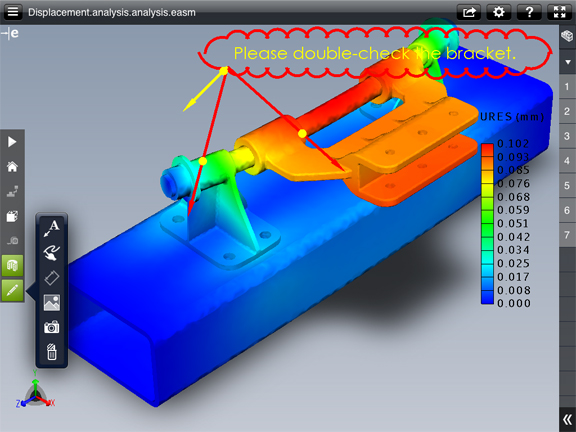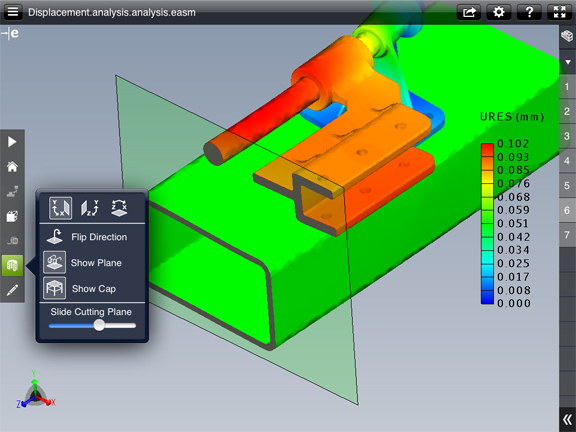Latest News
February 5, 2013
More than a decade ago, when stress analysis modules started showing up in mechanical design packages, users squirmed: Can we trust the software to accurately predict how steel and plastic shapes would deform under a certain weight or pressure? The inputs required are too complex. Where do I get these values? How do I make sense of the color-coded results? What does the Von Mises numbers say about my design?
But over time, the user interface for CAD-embedded linear stress analysis tools became simpler. Now, they have become so standardized that if you know how to perform stress analysis in SolidWorks, you can, with minimum training, perform the same task in Autodesk Inventor, Siemens PLM Software’s Solid Edge, or PTC Creo on first contact.
The new challenge for design software makers is to nudge their loyal users toward advanced simulation, spanning computer-fluid dynamics (CFD), thermal, airflow, electromagnetic, and more. In SolidWorks Premium, the software incorporates motion analysis, structural analysis, and tolerance stack-up analysis.
Separate from various editions of SolidWorks, the company also offers a series of Simulation packages, branded as SolidWorks Simulation. The higher end edition, SolidWorks Simulation Premium, offers drop test, frequency analysis, thermal structural analysis, finite element analysis, vibration analysis, and more. Another specialized package, SolidWorks Flow Simulation, offers CFD, thermal, and electronics thermal analysis, among others.
Can design software makers make simulation, a highly specialized discipline, more accessible to general designers and engineers by packaging it inside intuitive user interfaces, sophisticated algorithms, and simplified setup? Delphine Genouvrier, SolidWorks’ product manager for Flow Simulation and 3DVIA Composer, seems to think it’s possible.
During our conversation at SolidWorks World 2013, Genouvrier said, “[Our product] is driven by engineering goals. We simplified the inputs. You do not need to explain if you have a turbulent or laminar flow. The software will know. Is [the fluid flow] laminar, turbulent, or one that transitions from laminar to turbulent? The software takes care of that. Same thing with mesh. The software takes care of the density where it’s needed. You can refine it manually if you know how to. But the point is, you are able to run CFD without knowing a lot about CFD.”
The aim, explained Genouvrier, is to automate many aspects of advanced simulation so mechanical engineers can run initial design tests without a lot of expertise. But to get more value from the software, the user may need some training—not the kind that teaches you where the menu buttons are, but the kind that teaches you how to translate physical events into software-understandable simulation scenarios.
Since simulation is compute-intense, most modern simulation software programs are written to exploit parallel processing, made possible by multicore CPUs and GPUs. But there’s a cost to obtain the performance boost; most simulation software vendors require you to purchase high-performance computing (HPC) licenses. Simply put, the more cores you use to run the software, the more it costs. In that respect, SolidWorks is among the exception.
“We thought it would be unfair to add a per-core fee,” said Genouvrier. “It’s the same price, whether you’re using SolidWorks Simulation with eight cores or 16 cores.” It should be clarified, however, that SiolidWorks Simulation doesn’t support solving on remote HPC servers; it’s meant to be solved on computing cores available on the same machine. SolidWorks Flow Simulation, however, does support HPC environment. There’s no additional fee for running Flow Simulation in HPC with hundreds of cores, according to Genouvrier.
SolidWorks Simulation currently doesn’t support GPU-based simulation, but the company is looking into the possibility, explained Genouvrier. SolidWorks Flow Simulation can take advantage of the GPU’s acceleration in meshing models, she added. Many simulation users look to the GPU as a potential performance accelerator because it can augment the CPU’s processing power with hundreds of parallel processing cores.
“Lots of companies still see simulation as a complex process,” noted Genouvrier. “They use simulation at the end of the product design cycle, when they need to meet regulations, for example. Our job is to explain that simulation tools are to be used while you’re designing a product—as a concurrent engineering tool.”
As part of its efforts to make simulation more accessible, SolidWorks added support for simulation result files in its iPad viewer eDrawings. With the latest version of eDrawings, you can view outcome exported from SolidWorks Simulation, add notes to it, and see cross-sectional views of stress distribution.
SolidWorks is not alone in its ambition to make advanced simulation more accessible to general CAD users. Both CAD software makers and simulation software makers see this as the next opportunity for expansion. By its very nature, the most complex simulation jobs will remain the domain of experts. But the efforts of software vendors could lead to a wider use of simulation software among designers and engineers in earlier phases of design development, not for verification after the fact but for exploring viable design options.
Powering simulation with GPU is expected to be one of the themes explored at upcoming GPU Technology Conference, hosted by NVIDIA.
Subscribe to our FREE magazine, FREE email newsletters or both!
Latest News
About the Author
Kenneth Wong is Digital Engineering’s resident blogger and senior editor. Email him at [email protected] or share your thoughts on this article at digitaleng.news/facebook.
Follow DERelated Topics








